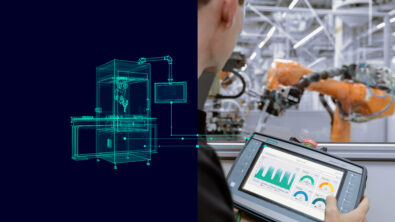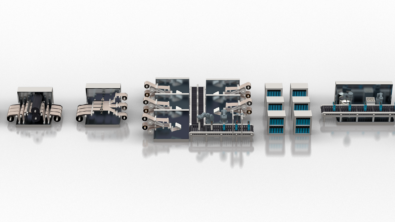PLM for Machine Builders (Teamcenter X) meets manufacturers’ challenges in ETO and CTO – Transcript

PLM for machine builders in the cloud changes the product development process, fundamentally impacting how a business operates. Machine builders can blend their engineer-to-order (ETO), and configure-to-order (CTO) demands.
In the transcript below, this third podcast discusses the Teamcenter X solution with our host Chris Pennington, Global Industry Marketing Leader for Industrial Machinery at Siemens Digital Industries Software, and Jaques Mostert, Solution Director for Industrial Machinery at Siemens Digital Industries Software. They will discuss how customers for industrial machinery will always require a level unique to each machine as companies sometimes make different products.
Check out the transcript below, learning more details in this third PLM Machine Builders series podcast.
You can also listen to the audio podcast.
Read the transcript
Chris: Today we will discuss how the cloud is changing the product development process and fundamentally impacting how a business operates. We will examine how machine builders can blend their engineer-to-order (ETO), and configure-to-order (CTO) demands. My colleague, Jaques Mostert, Solution Director for Industrial Machinery at Siemens Digital Industries Software, joins me.
Jaques has experience implementing PLM and CAD software and using it in the industry.
After working for a distributor of Siemens software for ten years, where he led team implementations, Jaques then spent another 12 years working for equipment suppliers in the mining industry.
During this time, he worked in various roles, including mechanical engineer, project engineer, and engineering manager. Finally, before returning to Siemens, he was a VP of Engineering, managing a globally distributed multidisciplinary team of over 300 members.
Jaques, before we begin, please say a few words about yourself and your experience with industrial machinery.
Jaques: Yes, Chris, thank you for that introduction. And as you said, I started my career in the PLM field. I was focusing on implementing the PLM system, Teamcenter. So over ten years ago, I moved into this industry, where I spent a few years managing multidisciplinary engineering teams. The companies I worked with supplied mineral processing equipment; traditionally, these types of companies provided the spoke equipment.
Supplying equipment on this engineer to order bases was becoming more and more challenging to deliver profitably over time. Engineer to order (or ETO) comes inherently with increased risk of areas when doing something for the first time. So, it naturally follows that these companies need to find ways to reuse previous designs more, which leads to a configure-to-order (or CTO) way of working. Because customers for industrial machinery need companies that don’t all make the same products, as there will always be a level of uniqueness to a machine, and although there is some level of reuse possible, it can be a complete copy of what was done before.
So, the result is an engineering environment where ETO and CTO practices must be mixed. And as the machines get smarter, so do the software electronics, becoming more significant and integral to the product. Gone are the days when an electrical engineer’s job is to make the mechanical components move. An excellent concise way to describe the current situation is complexity.
And if we don’t combine this with the pressure to improve profitability, complexity can no longer be managed through spreadsheets and emails. Instead, we need a managed environment where multidisciplinary teams can collaborate in real time in one place. So, this is the background for the motivation for a tool like PLM for machine builders.
Chris: That’s an interesting background, Jaques. I hear a lot about balancing engineer to order and configuring to order. You mentioned the PLM for machine builders’ SaaS solution. Could you talk about what that delivers?
Jaques: Sure. So, the PLM for machine builders is a preconfigured system. In other words, it’s ready to go out of the box. When we developed this configuration, we considered the workflows for typical company supply machinery. Most machines need to be unique in some way. This means most companies’ machines must work in a configured order and engineered-to-order way. Philips machine builders were built with this in mind. This solution allows companies to manage the requirements that they see from customers. Because of the ETO aspect, there will be changes to manage, which this system helps manage most effectively.
And then, of course, the backbone of all design processes is the cloud solution, which allows you to take control of your CAD data. And not only CAD data supplied by Siemens but from all the main CAD vendors. Having your CAD data stored in the cloud, the PLM system makes it possible for a globally dispersed team always to have access to the latest version and to derive materials that are directly derived from the CAD. Also, even people without access have access to the lightweight 3D model and 3D drawings via the built-in viewer.
Chris: Preconfigured PLM sounds like a great idea. As you’ve been developing this solution, what are the challenges for machine builders that you are aiming to address?
Jaques: Well, there are certainly many challenges that machine builders need to deal with these days.
There are a lot of disruptive influences at the moment. We all know about the general geopolitical uncertainty in the world. We all came through the COVID period in the last three years.
And this resulted in massive disruptions, especially in the supply chain, which put pressure on machinery companies. So, there’s a drive to be more productive or to get more done with less. One of the other disruptive influences I have yet to mention is that many companies are struggling today to get the right talent.
To deal with this, factories must become automated and therefore become smarter. And when the factory becomes smarter and more automated, the machines in those factories also need to become smarter. This is because these machines are more connected with more sensors and are controlled by sophisticated automation systems.
All these smart and connected machines generate massive amounts of data that must be analyzed. Or they can be analyzed to improve processes and drive more optimization. If you take all this back to the engineering perspective, it all results in a much more complex engineering process.
Engineers these days are more likely to work from home to distribute it. However, smarter machines have also come with a flip side to the coin. As machine builders place smarter connected machines into the field, these machine builders are learning to track the operational life data.
That is potentially a brand-new business model for them, where they can offer these machines as a service.
So, machines-as-a-service doesn’t sell them the machine per se, but you sell the throughput of that machine.
This process is challenging the traditional operating models of many companies, so it’s fair to state that machine builders are currently dealing with some fairly complicated situations.
Chris: Yeah, I must agree that the list of challenges is quite daunting, Jaques. So, from the perspective of return on investment, what can address the challenges?
Jaques: Well, there are a few things that can be done. Top of mind is improving productivity. One of the easiest ways to improve productivity is not to do something more than once, or in other words, do you use what you’ve done before?
And remember that we’re talking about companies that supply machines with something unique about them all of the time, so it’s bringing us back to the concept of a blended CTO and ETO way of working, which is quite complicated; therefore, you need help. You need a system that can manage machine configurations to maximize the use while still being flexible enough to allow companies to offer ETO services to meet those bespoke requirements from customers.
The system I’m talking about here is a PLM system. They can be complicated to implement, causing a barrier for small-to medium-sized companies to use the software. Typically, the more advanced capabilities are out of reach for all but large enterprises. Cloud solutions is like a telephone for machine builders, offering ready-to-use cloud-based solutions to manage processes like requirements management, project planning and changes.
And it includes best practices, out-of-the-box with no need to develop and maintain these systems with internal IT system resources.
Therefore, these cloud solutions enable small and medium companies to access these advanced PLM systems to update, maintain and manage this complexity. And on top of this, because Siemens developed the software, it’s the best place to upgrade, maintain them, and that’s the basis of a solution at Siemens. Subsequently, we will upgrade these solutions as new versions become available.
Chris: So, just going back to PLM for machine builders, what specifically does the solution do to solve these challenges?
Jaques: Well, some of this have been discussed already. But we’ve taken our deep industry knowledge and our process-based approach to look at the processes in the typical machinery company and the technologies as a suite, using these two and combining them to configure a system that provides the most effective way to solve the needs of machinery companies.
So, in a blended ETO environment, there are many moving parts all the time. It is not possible to deliver a new order by only using previous designs. It’s essential to manage new designs as well.
PLM for machine builders comes with an integrated design process and project management tool that helps you to keep all your ducks in a row.
As mentioned a couple of times, the customers for the machinery companies all have unique requirements.
So, you need to manage those requirements and link them to the design clearly and concisely.
Philips machine builders come with a requirements management module that allows you to manage each requirement as its own data object, which you can then link to the design for complete closed-loop traceability.
And then, obviously, like we said a few times, things will change. It’s a fact of life in countries like this.
When change happens, machine builders can help ensure that communication is clear. It helps understand the impact of the change and provides data objects so that all relevant data is captured and managed in the context of the change.
We also talked about the need for smarter machines, which means more electrical and software in the machines, and all on a software-as-a-service basis.
As mentioned, it’s all built on the PLM system Teamcenter, with its industry-leading range of PLM capabilities.
Therefore, it provides a great starting point for companies to get started on the PLM journey. If the company then grows and believes machine builders are insufficient, you’ve got Teamcenter (as a basis) to grow to other capabilities later.
Chris: That’s great, Jaques. So, I’m afraid that’s all we have time for today. Great conversation. And thanks again for joining me in this discussion and for sharing your knowledge on industrial machinery product development. And thanks to our listeners for joining us in this third episode of the series. Please stay tuned for the next podcast in this series. Enjoy the remainder of your day.
Thank you and goodbye.
Siemens Xcelerator, the comprehensive and integrated portfolio of software and services from Siemens Digital Industries Software, helps companies of all sizes create and leverage a comprehensive digital twin that provides organizations with new insights, opportunities and levels of automation to drive innovation.
For more information on Siemens Digital Industries Software products and services, visit siemens.com/software or follow us on LinkedIn, Twitter, Facebook and Instagram. Siemens Digital Industries Software – where today meets tomorrow.


